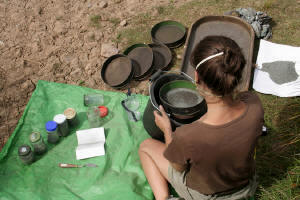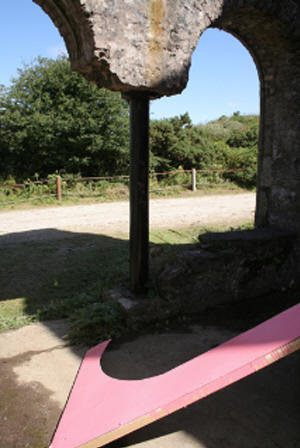|
|
| home | exhibitions | interviews | features | profiles | webprojects | archive |
|
Wheal Art Weekend: history and folk memory Megan Wakefield
The spectacular industrial ruins of South
Wheal Frances were the setting for a public event featuring 11 artists,
6 from the Level Two Artist’s
Led Initiative and 5 invited participants. As project writer, I wanted
to see how they would engage with a site that had recently been granted
World Heritage status. Should site-specificity oblige the artists to
explore the past and how would they navigate a path through the complex
history and folk memory that surrounds such a place? Artists Stacey Righton (right) and Sara Bowler used the rock itself as a catalyst for enquiry. Stacey worked on site smashing 5kg of copper ore on an iron “bucking plate” then sieved the pieces to grade them into granules of differing sizes. This repetitive process was an amalgamation of two ways in which copper and tin ore were treated, copper being smashed and separated by the Bal Maidens and tin stamped and graded. Like the Bal Maids, Stacey was highly visible, consciously absorbed in a process that wasn’t “productive”, yet had the trappings of a performance and demonstration alike.
A similar cycle of repetition featured in Sara
Bowler’s piece Strange
Flowerings. This
multitude of sea pinks, 2000 woollen pompoms on copper coated wire
stalks, was planted in the grass to form a swathe along the direction of
the vast underground mineral seam called the Great Flat Lode. Thrift is
known to indicate mineral deposits beneath the subsoil, so was
appropriate for a deliberately reclaimed area that had been scarred by
industrial processes. The title of Alexis Stevens’ installation (below) both echoed these strange flowerings and encapsulated a constant forgetting. Under the Thrift was qualified with the Basho haiku: “The summer grass is as if the warrior were a dream” Alexis had chosen the room at the end of the Miner’s “Dry” basing the elements of her piece on a scaled down version of one of the windows. Four large archways faced one another, the curvature of one dramatically broken. Grass and branches had begun to encroach from the thicket next door, creating an ideal theatre for her installation. Set at an obtuse angle to one another, these truncated vaults served to emphasize the architecture around them, so that the eye of the viewer travelled from grass to green turf, from wooden horizontal to stone vertical plane, bridging the gaps between and forming a more complete visual narrative.
An arch painted thrift-pink was one of the
colour surprises of the site. Frequent fragments of artificial colour
appeared like attempts to activate the stone ruins, yet were not always
to be read as allusions to their industrial past. Alison Sharkey, for
example disrupted the monumental stillness with her sound and video
piece Balls. A screen
placed in a niche at the end of the former Compressor Room showed a film
of fluro yellow rubber balls being flung into the same space. As they
careered from wall to wall and disappeared into the filthy water below,
the randomness of their trajectories defied the insistent rhythm of
their bounce. In the Pumping Engine House Steven Paige had placed a mirror reflecting a circle of sky at the top of the stack. A sound recording played extracts from original news footage about the fateful stock market crash of 1985 that had decimated the Cornish tin industry. This babbled on regardless while the disc of daylight glinting behind iron bars told of the dream of a richer lode, greater investment, a better life. Images of migration, flight and freedom were explored by Kate Ogley and Stephanie Boon, against a backdrop of darker issues such as child labour in BoyWorkings. Andy Whall used the architecture to experiment with movement from physical constriction to symbolic activity in his performance Arsenic Licker whilst the Quaylab artist Paul Chaney concentrated on activity in the micro-cosmos. Dressed as an Edwardian scientist he performed an exploration of the biodiver-sity of the site, the Notion of Inhuman Endeavour on a Site Renowned for Human Endeavour. Wheal Art Weekend was never meant as a celebration of mining heritage. It’s coherence lay instead in its emphasis on the vulnerable and precarious aspects of that life. It combined spatial responses to the empty, fragmented buildings with exposure of the hidden stories that are overlooked by history.
Text Megan Wakefield Pictures Miranda May August 2006
|
|
|



